2007 CHEVROLET EXPRESS CARGO VAN child seat
[x] Cancel search: child seatPage 1 of 458
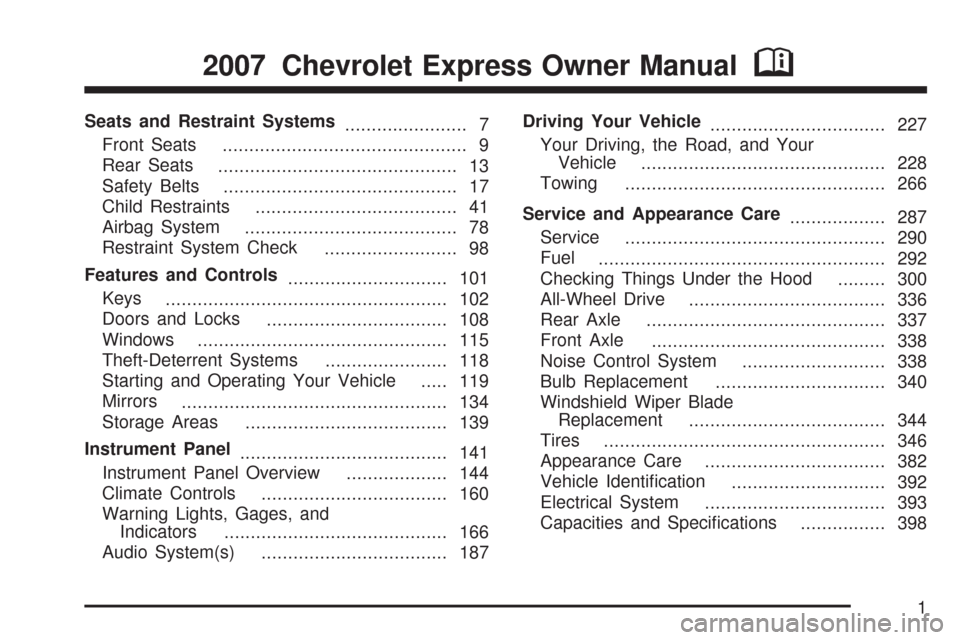
Seats and Restraint Systems
....................... 7
Front Seats
.............................................. 9
Rear Seats
............................................. 13
Safety Belts
............................................ 17
Child Restraints
...................................... 41
Airbag System
........................................ 78
Restraint System Check
......................... 98
Features and Controls
.............................. 101
Keys
..................................................... 102
Doors and Locks
.................................. 108
Windows
............................................... 115
Theft-Deterrent Systems
....................... 118
Starting and Operating Your Vehicle
..... 119
Mirrors
.................................................. 134
Storage Areas
...................................... 139
Instrument Panel
....................................... 141
Instrument Panel Overview
................... 144
Climate Controls
................................... 160
Warning Lights, Gages, and
Indicators
.......................................... 166
Audio System(s)
................................... 187Driving Your Vehicle
................................. 227
Your Driving, the Road, and Your
Vehicle
.............................................. 228
Towing
................................................. 266
Service and Appearance Care
.................. 287
Service
................................................. 290
Fuel
...................................................... 292
Checking Things Under the Hood
......... 300
All-Wheel Drive
..................................... 336
Rear Axle
............................................. 337
Front Axle
............................................ 338
Noise Control System
........................... 338
Bulb Replacement
................................ 340
Windshield Wiper Blade
Replacement
..................................... 344
Tires
..................................................... 346
Appearance Care
.................................. 382
Vehicle Identification
............................. 392
Electrical System
.................................. 393
Capacities and Specifications
................ 398
2007 Chevrolet Express Owner ManualM
1
Page 7 of 458
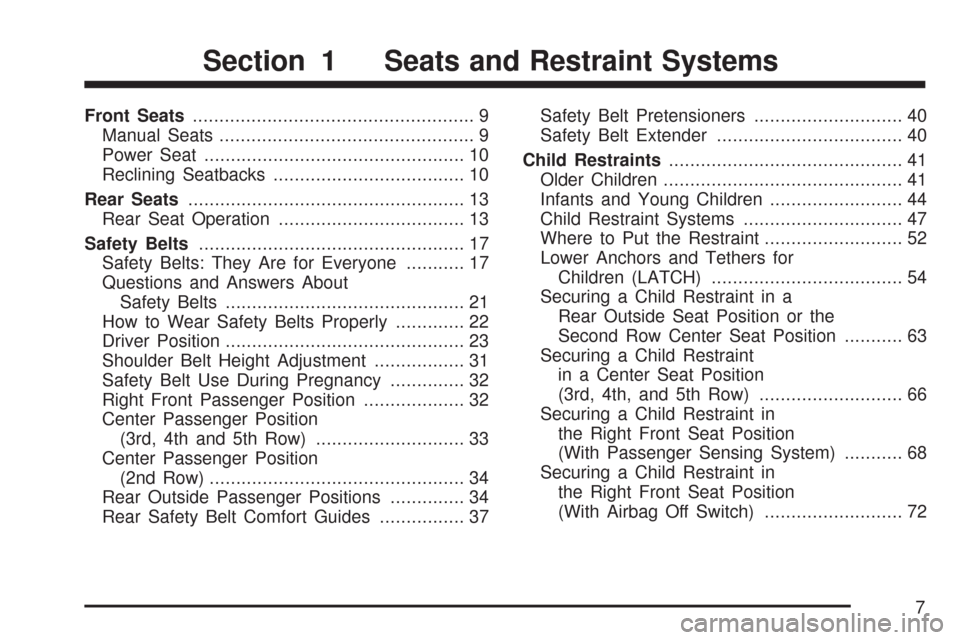
Front Seats..................................................... 9
Manual Seats................................................ 9
Power Seat................................................. 10
Reclining Seatbacks.................................... 10
Rear Seats.................................................... 13
Rear Seat Operation................................... 13
Safety Belts.................................................. 17
Safety Belts: They Are for Everyone........... 17
Questions and Answers About
Safety Belts............................................. 21
How to Wear Safety Belts Properly............. 22
Driver Position............................................. 23
Shoulder Belt Height Adjustment................. 31
Safety Belt Use During Pregnancy.............. 32
Right Front Passenger Position................... 32
Center Passenger Position
(3rd, 4th and 5th Row)............................ 33
Center Passenger Position
(2nd Row)................................................ 34
Rear Outside Passenger Positions.............. 34
Rear Safety Belt Comfort Guides................ 37Safety Belt Pretensioners............................ 40
Safety Belt Extender................................... 40
Child Restraints............................................ 41
Older Children............................................. 41
Infants and Young Children......................... 44
Child Restraint Systems.............................. 47
Where to Put the Restraint.......................... 52
Lower Anchors and Tethers for
Children (LATCH).................................... 54
Securing a Child Restraint in a
Rear Outside Seat Position or the
Second Row Center Seat Position........... 63
Securing a Child Restraint
in a Center Seat Position
(3rd, 4th, and 5th Row)........................... 66
Securing a Child Restraint in
the Right Front Seat Position
(With Passenger Sensing System)........... 68
Securing a Child Restraint in
the Right Front Seat Position
(With Airbag Off Switch).......................... 72
Section 1 Seats and Restraint Systems
7
Page 37 of 458
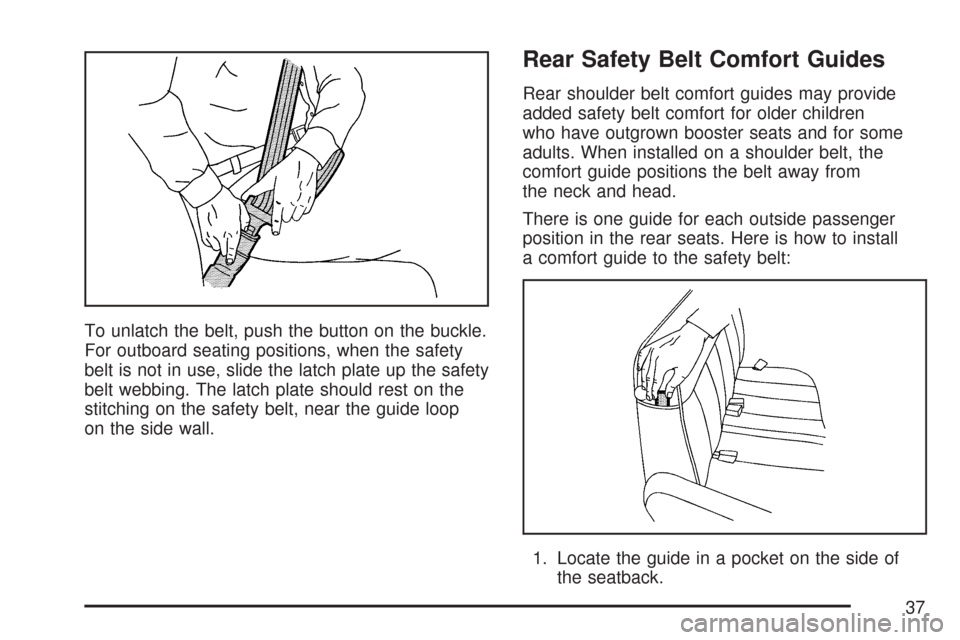
To unlatch the belt, push the button on the buckle.
For outboard seating positions, when the safety
belt is not in use, slide the latch plate up the safety
belt webbing. The latch plate should rest on the
stitching on the safety belt, near the guide loop
on the side wall.
Rear Safety Belt Comfort Guides
Rear shoulder belt comfort guides may provide
added safety belt comfort for older children
who have outgrown booster seats and for some
adults. When installed on a shoulder belt, the
comfort guide positions the belt away from
the neck and head.
There is one guide for each outside passenger
position in the rear seats. Here is how to install
a comfort guide to the safety belt:
1. Locate the guide in a pocket on the side of
the seatback.
37
Page 40 of 458
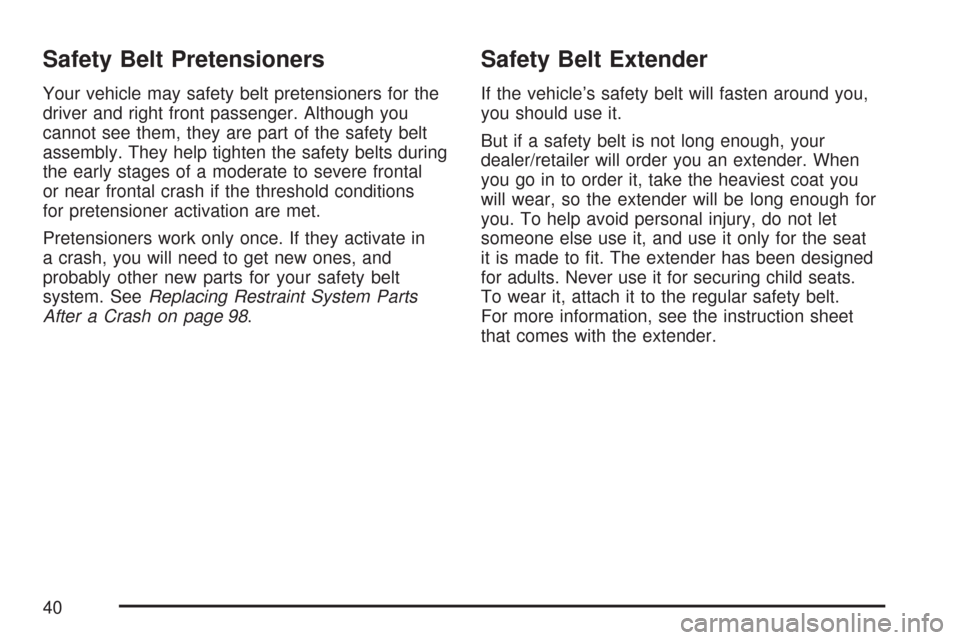
Safety Belt Pretensioners
Your vehicle may safety belt pretensioners for the
driver and right front passenger. Although you
cannot see them, they are part of the safety belt
assembly. They help tighten the safety belts during
the early stages of a moderate to severe frontal
or near frontal crash if the threshold conditions
for pretensioner activation are met.
Pretensioners work only once. If they activate in
a crash, you will need to get new ones, and
probably other new parts for your safety belt
system. SeeReplacing Restraint System Parts
After a Crash on page 98.
Safety Belt Extender
If the vehicle’s safety belt will fasten around you,
you should use it.
But if a safety belt is not long enough, your
dealer/retailer will order you an extender. When
you go in to order it, take the heaviest coat you
will wear, so the extender will be long enough for
you. To help avoid personal injury, do not let
someone else use it, and use it only for the seat
it is made to fit. The extender has been designed
for adults. Never use it for securing child seats.
To wear it, attach it to the regular safety belt.
For more information, see the instruction sheet
that comes with the extender.
40
Page 41 of 458
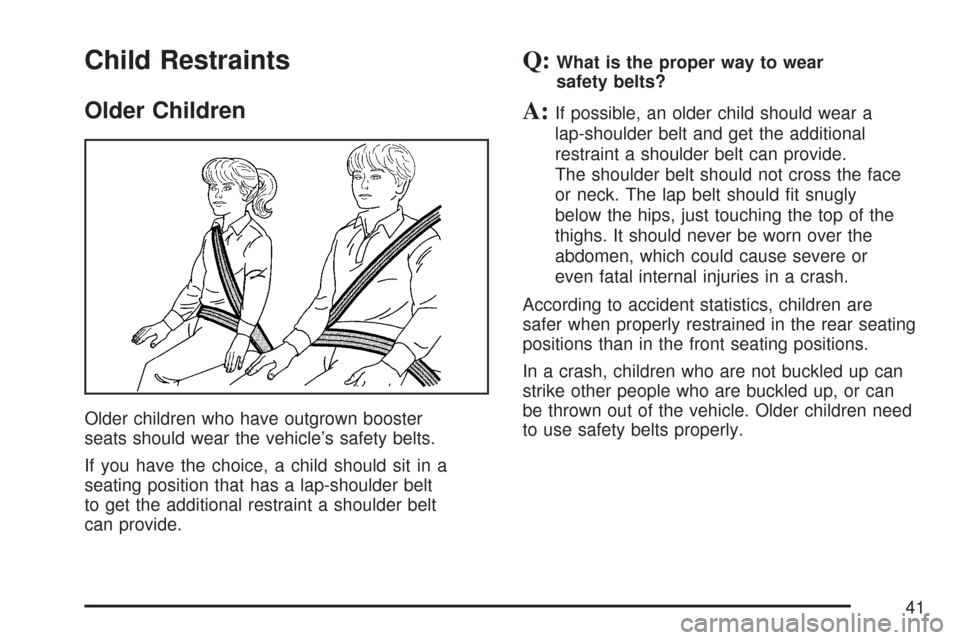
Child Restraints
Older Children
Older children who have outgrown booster
seats should wear the vehicle’s safety belts.
If you have the choice, a child should sit in a
seating position that has a lap-shoulder belt
to get the additional restraint a shoulder belt
can provide.
Q:What is the proper way to wear
safety belts?
A:If possible, an older child should wear a
lap-shoulder belt and get the additional
restraint a shoulder belt can provide.
The shoulder belt should not cross the face
or neck. The lap belt should fit snugly
below the hips, just touching the top of the
thighs. It should never be worn over the
abdomen, which could cause severe or
even fatal internal injuries in a crash.
According to accident statistics, children are
safer when properly restrained in the rear seating
positions than in the front seating positions.
In a crash, children who are not buckled up can
strike other people who are buckled up, or can
be thrown out of the vehicle. Older children need
to use safety belts properly.
41
Page 42 of 458
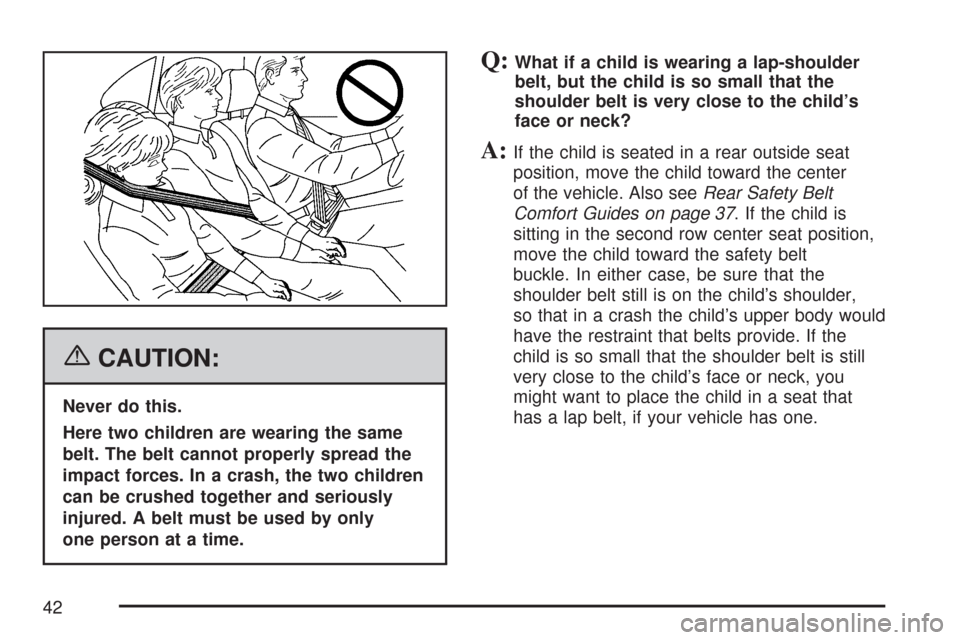
{CAUTION:
Never do this.
Here two children are wearing the same
belt. The belt cannot properly spread the
impact forces. In a crash, the two children
can be crushed together and seriously
injured. A belt must be used by only
one person at a time.
Q:What if a child is wearing a lap-shoulder
belt, but the child is so small that the
shoulder belt is very close to the child’s
face or neck?
A:If the child is seated in a rear outside seat
position, move the child toward the center
of the vehicle. Also seeRear Safety Belt
Comfort Guides on page 37. If the child is
sitting in the second row center seat position,
move the child toward the safety belt
buckle. In either case, be sure that the
shoulder belt still is on the child’s shoulder,
so that in a crash the child’s upper body would
have the restraint that belts provide. If the
child is so small that the shoulder belt is still
very close to the child’s face or neck, you
might want to place the child in a seat that
has a lap belt, if your vehicle has one.
42
Page 43 of 458
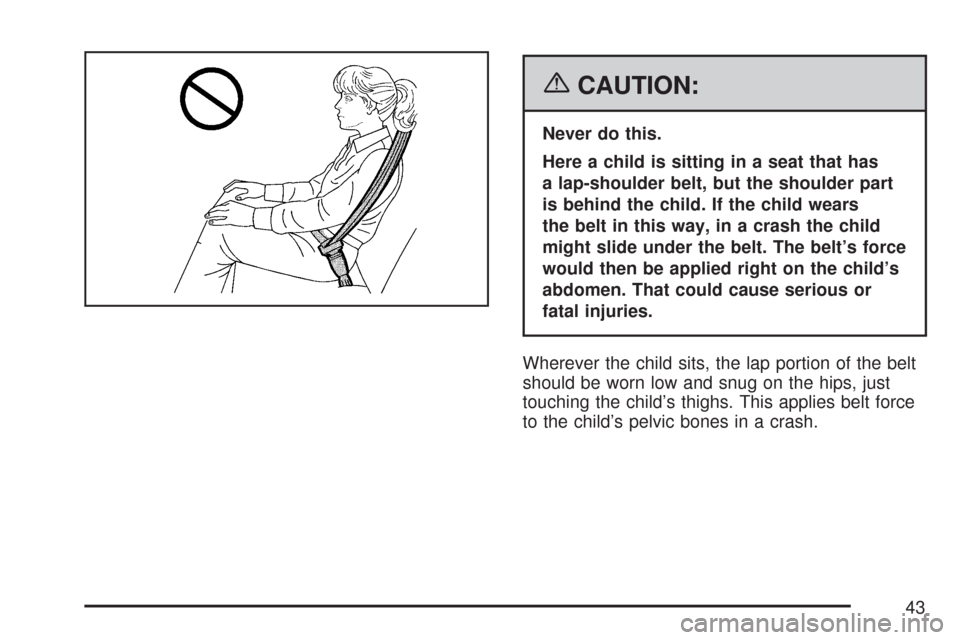
{CAUTION:
Never do this.
Here a child is sitting in a seat that has
a lap-shoulder belt, but the shoulder part
is behind the child. If the child wears
the belt in this way, in a crash the child
might slide under the belt. The belt’s force
would then be applied right on the child’s
abdomen. That could cause serious or
fatal injuries.
Wherever the child sits, the lap portion of the belt
should be worn low and snug on the hips, just
touching the child’s thighs. This applies belt force
to the child’s pelvic bones in a crash.
43
Page 46 of 458
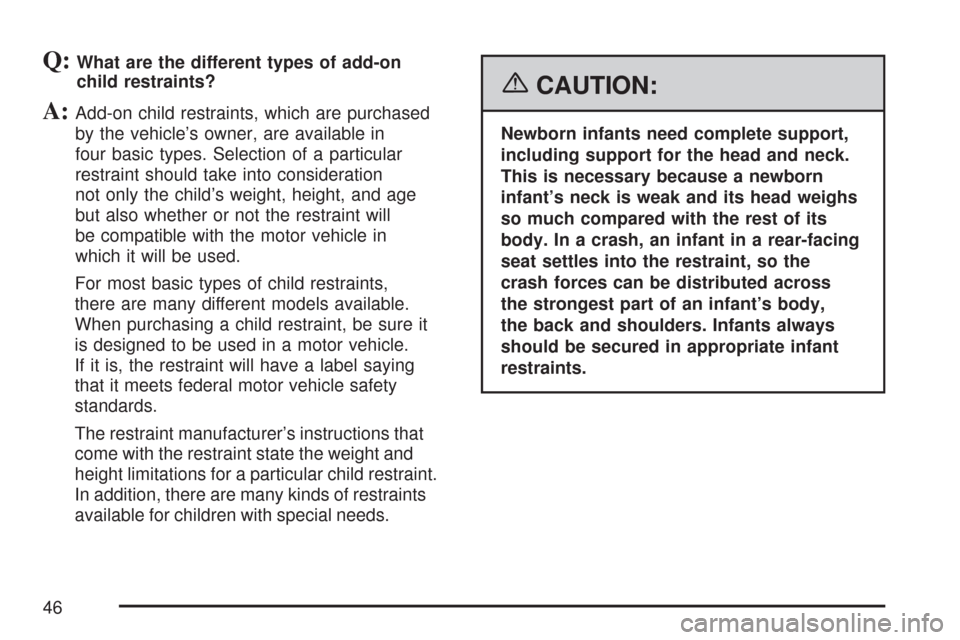
Q:What are the different types of add-on
child restraints?
A:Add-on child restraints, which are purchased
by the vehicle’s owner, are available in
four basic types. Selection of a particular
restraint should take into consideration
not only the child’s weight, height, and age
but also whether or not the restraint will
be compatible with the motor vehicle in
which it will be used.
For most basic types of child restraints,
there are many different models available.
When purchasing a child restraint, be sure it
is designed to be used in a motor vehicle.
If it is, the restraint will have a label saying
that it meets federal motor vehicle safety
standards.
The restraint manufacturer’s instructions that
come with the restraint state the weight and
height limitations for a particular child restraint.
In addition, there are many kinds of restraints
available for children with special needs.
{CAUTION:
Newborn infants need complete support,
including support for the head and neck.
This is necessary because a newborn
infant’s neck is weak and its head weighs
so much compared with the rest of its
body. In a crash, an infant in a rear-facing
seat settles into the restraint, so the
crash forces can be distributed across
the strongest part of an infant’s body,
the back and shoulders. Infants always
should be secured in appropriate infant
restraints.
46